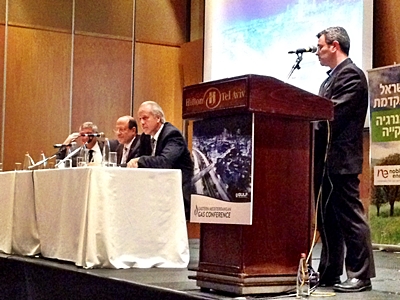EMGC ’14: Eastern Mediterranean leaders mull viability of LNG, CNG, pipeline proposals
3/11/2014 12:00:00 AM
By ADRIENNE BLUME
Managing Editor
Managing Editor

TEL AVIV, Israel -- Following a bountiful Mediterranean lunch served at the Hilton Tel Aviv, Day 1 of the EMGC 2014 conference resumed with several presentations and a panel discussion on the opportunities available in the Eastern Mediterranean, including those for liquefied natural gas (LNG) exports and for floating LNG, compressed natural gas (CNG) and pipeline projects.
Session chair Natanel Haiman, the head of the Energy and Business Economics departments at the Manufacturers' Association of Israel, introduced opening speaker Gina Cohen, a prominent Eastern Mediterranean gas consultant. Ms. Cohen spoke at length about the complexities and interconnections of the regional gas market, and presented options for how best to capitalize on Israel's growing gas resource.
Israeli gas export opportunities and challenges. Global gas trading patterns are changing, Ms. Cohen said, as 10% of the world's gas is now moved as LNG. Additionally, gas pricing is becoming increasingly based on gas-on-gas fundamentals. Prices are moving away from oil indexes and toward US Henry Hub natural gas pricing as LNG trade ramps up. In the US, nearly 40% of the gas produced is associated gas, making it a cheap resource and affecting pricing fundamentals elsewhere in the world.
"It is said that, when the US sneezes, the rest of the world catches a cold," Ms. Cohen quipped, illustrating the impact of low US natural gas pricing on Europe, Asia and the Mediterranean. In major gas-importing counties, such as Japan and Turkey, large trade deficits create complexities in energy trade, while in major gas-exporting nations, export prices may increase substantially.
Ms. Cohen explained that Israel is legally required to keep 540 billion cubic meters of gas to meet domestic needs. There are a number of export options for Israel's growing gas reserves, including pipelines, LNG and FLNG. Ms. Cohen said a pipeline to Jordan or Egypt is not likely to happen. She also noted that a pipeline to Turkey, while an attractive option, would be complicated by competition with Azerbaijan gas pipeline shipments and by legal restrictions arising from competition between Cyprus and Turkey to become a regional energy hub. A pipeline to Greece is another possibility.
Israel's LNG export options include onshore LNG along Israel's Mediterranean coast, or in Eilat in the Red Sea region; onshore LNG in Cyprus; onshore LNG in Egypt, which already has two facilities; an Israeli FLNG project, which would enable the country to maintain control over its gas and keep prices low; or FCNG, a project concept for which investors and buyers must still be secured.
Ms. Cohen concluded her presentation with an outline of the easiest options from the technical, commercial and political points of view. Technically, the easiest option is a short pipeline to Jordan or Egypt, which would avoid transit-country complications and enable fast transport of gas.
Commercially, LNG could be sent to the Far East from an onshore or offshore facility. Ms. Cohen acknowledged that FLNG technology is unproven, although it is approximately 20% cheaper than onshore LNG. From a political point of view, the easiest option would be to sell gas to energy-hungry Turkey, although this could be a risky path for sellers due to the potential challenges posed by transit countries.
The session continued with a panel discussion on LNG, FLNG, CNG and deepwater concepts that included executive speakers from Wood Group Mustang, Sea NG Corp. and Hiram Landau Ltd.
 FLNG and FCNG options. Chris Barton, senior vice president of offshore business development for Wood Group Mustang, noted that lead times for offshore gas projects can be extensive; pre-FEED for an FLNG project can take 12–15 months. Influence on cost is greatest at the front end. "You don't want a train wreck at the end" due to poor front-end planning, Mr. Barton said. "Execution strategy is important, and successful planning is essential."
FLNG and FCNG options. Chris Barton, senior vice president of offshore business development for Wood Group Mustang, noted that lead times for offshore gas projects can be extensive; pre-FEED for an FLNG project can take 12–15 months. Influence on cost is greatest at the front end. "You don't want a train wreck at the end" due to poor front-end planning, Mr. Barton said. "Execution strategy is important, and successful planning is essential." With the progression of FLNG projects in Australia and Southeast Asia, FLNG is becoming an increasingly viable option for the production and export of natural gas. These projects are setting a precedent for possible FLNG projects in the Eastern Mediterranean, Mr. Barton said.
Next, Adam Hedayat, the vice president of business development for Sea NG Corp. (photo 1), gave an overview of the differences between CNG and LNG vessels and transport. He outlined a regional niche for CNG and/or floating CNG (FCNG) as an affordable solution for small or stranded gas reserves to be shipped less than 3,500 km, where pipeline and LNG shipments are impractical or too expensive. In the Eastern Mediterranean, Mr. Hedayat sees CNG export opportunities to Crete, Italy, Greece and several other countries located within the optimal shipping distance from Israel.
A question-and-answer session followed the remaining speaker presentations, allowed Mr. Hedayat and Yigal Landau, managing director of Hiram Landau Ltd., to debate the pros, cons and feasibilities of FCNG and FLNG projects with conference attendees (photo 2).
Deepwater gas pipeline design challenges. One of the last topics covered during the session was the technical challenges of deepwater, long-distance pipeline projects, from both a design and installation perspective. Jeroen Timmermans, the engineering director of INTECSEA, explored the question of whether the technology gap for deepwater gas pipelines is on the verge of being closed.
Pressure, diameter and length are the primary considerations and limitations in the hydraulic design of deepwater pipelines. Compression system requirements are significant in terms of construction and operational costs, and operators should aim to remain within proven limits, Mr. Timmermans said.
The mechanical design of deepwater pipelines is another essential consideration, as these pipelines must be designed with proper wall thickness to withstand high external pressures and pressure transitions from deepwater to land. By contrast, shallow-water pipeline design is mainly focused on internal pressure.
The routing of a deepwater gas pipeline is often the most complicated design aspect of the project, Mr. Timmermans explained. National boundaries, seabed conditions, the overall length of the pipeline, protected areas and other sea uses must be taken into consideration.
Survey programs for deepwater pipelines include several phases and are critical for route confirmation, collection of engineering data and the qualification and quantification of geohazards. Typically, survey activities drive the critical path for deepwater pipeline project design, Mr. Timmermans said.
Deepwater pipeline options from the Levant basin in the Eastern Mediterranean include a line to Cyprus, which would require an approximate length of 200 kilometers (km) and be exposed to water depths of up to 2,350 m; a line to Israel (approximate length of 200 km and water depths of up to 1,650 m; a line to Turkey (approximate length of 500 km and water depths of up to 2,250 m); or a line to the Greek islands, which would require the longest and deepest route of 750 km and water depths of up to 3,000 m.
Is the technology gap for deepwater gas pipelines being closed? "Yes," says Mr. Timmermans."From an engineer's perspective, from a designer's perspective, I think we're already there." However, he cautioned that a strong design team must be in place to understand and quantify the risks and geohazards associated with the design of deepwater gas pipelines. "Large-diameter deepwater pipelines in the Eastern Mediterranean are challenging, but feasible," Mr. Timmermans concluded.






Comments